
The black-headed jay or lanceolated jay is roughly the same size as its close relative the Eurasian jay, but a little more slender overall except for the bill which is slightly shorter and thicker. The top of the head is black and it has a more obvious crest too and a longer tail.

Sody's tree rat is a rodent species in the family Muridae that has been recorded only in bamboo forest in Gunung Gede Pangrango National Park, West Java, Indonesia. It was first recorded during surveys carried out between 1933 and 1935 at an altitude of 1,000 m (3,300 ft). It is dark brown and has yellow to ochre spots. Its tail is uniform brown. Its head-to-body length ranges from 18 to 21 cm with a 27 to 30.5 cm long tail. Its long feet indicate that it is adapted to living in trees.
Kalophrynus nubicola is a species of frog in the family Microhylidae. It is endemic to Sarawak in Malaysian Borneo and is only known from the Gunung Mulu National Park. The specific name nubicola means "dwelling in cloud". Common names blue-spotted sticky frog and mossy-forest sticky frog has been coined for this species.
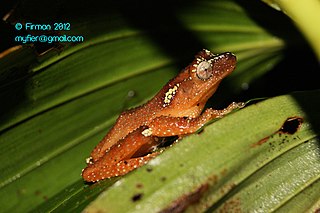
Nyctixalus margaritifer, also known as the Java Indonesian treefrog and pearly tree frog, is a species of frog in the family Rhacophoridae. It is endemic to Java, Indonesia, where it is known from a number of records at elevations above 700 m (2,300 ft).

Philautus everetti is a species of frog in the family Rhacophoridae found in the Philippines and Malaysia. Its natural habitats are subtropical or tropical moist lowland forests, subtropical or tropical moist montane forests, and rivers. It is threatened by habitat loss. In Borneo, this species occurs in the mountainous area from Gunung Kinabalu National Park in Sabah to Gunung Mulu National Park in Sarawak.
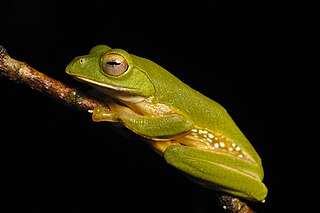
Rhacophorus pseudomalabaricus, also known as Anaimalai flying frog, false Malabar gliding frog, and false Malabar tree frog, is a species of frog in the family Rhacophoridae. It is endemic to the Anaimalai Hills, a part of the southern the Western Ghats in the Tamil Nadu and Kerala states, India.
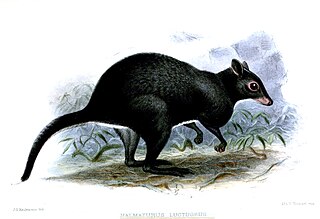
The gray dorcopsis or gray forest wallaby is a species of marsupial in the family Macropodidae. It is found in West Papua and Papua New Guinea.
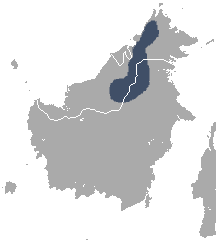
The Bornean smooth-tailed treeshrew is a species of treeshrew in the family Tupaiidae. It is endemic to Borneo. Its natural habitat is subtropical or tropical dry forests. It is threatened by habitat loss.

The Javan ferret-badger is a mustelid endemic to Java and Bali, Indonesia. It is listed as Least Concern on the IUCN Red List and occurs from at least 260 to 2,230 m elevation in or close to forested areas.

Anisoptera scaphula is a species of plant in the family Dipterocarpaceae. It is native to Bangladesh, Peninsular Malaysia, Laos, Myanmar and Thailand.
Shorea obtusa, the Siamese sal, is a species of hardwood tree in the family Dipterocarpaceae, native to Southeast Asia.
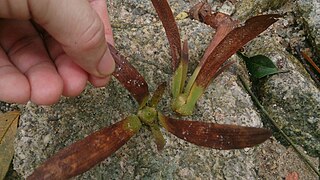
Dryobalanops lanceolata is a species of plant in the family Dipterocarpaceae. The species name is derived from Latin and refers to the shape of the leaf. This species is endemic to Borneo. It is common in protected areas, although elsewhere it has suffered modest population decline due to logging and land conversion.
Shorea crassa is a species of plant in the family Dipterocarpaceae. It is endemic to Borneo. The species name is derived from Latin and refers to thick leaf blade.

The Javan leopard is a leopard subspecies confined to the Indonesian island of Java. It has been listed as Endangered on the IUCN Red List since 2021. The population is estimated at 188–571 mature individuals in 22 fragmented subpopulations and a declining population trend. The total remaining habitat is estimated at only 2,267.9 to 3,277.3 km2.

The Borneo lowland rain forests is an ecoregion, within the tropical and subtropical moist broadleaf forests biome, of the large island of Borneo in Southeast Asia. It supports approximately 15,000 plant species, 380 bird species and several mammal species. The Borneo lowland rain forests is diminishing due to logging, hunting and conversion to commercial land use.
The Aceh rat is a species of rodent from the family Muridae. The Aceh rat is listed as Data Deficient on the IUCN Red List because only two specimens have ever been recorded, and little is known about the species. The species was first regarded as its own species and then as a subspecies of the Malayan field rat, but was once again considered distinct due to its small body size.

Palaquium gutta is a tree in the family Sapotaceae. The specific epithet gutta is from the Malay word getah meaning "sap or latex". It is known in Indonesia as karet oblong.
Palaquium kinabaluense is a tree in the family Sapotaceae. It is named after Mount Kinabalu in Malaysia's Sabah state, on Borneo.
Planchonella malaccensis is a tree in the family Sapotaceae. It is named after Malacca in Peninsular Malaysia.

Durio oxleyanus is a perennial plant species of tree in the family Malvaceae. It was once placed in the family Bombacaceae.
















